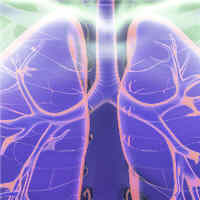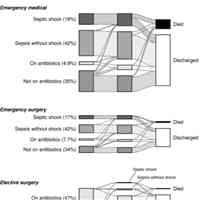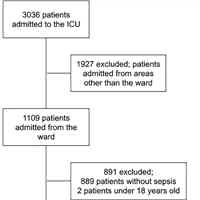Tag: sepsis

Hypocalcemia Association with In-hospital Mortality and Complications in Patients with Acute Pulmonary Embolism
Pulmonary Embolism (PE) patients with hypocalcemia have higher in-hospital mortality than those without hypocalcemia. The in-hospital complications were also higher, along with longer length of stay. In the 2017 NIS, 187,989... read more

MIF But Not MIF-2 Recruits Inflammatory Macrophages in an Experimental Polymicrobial Sepsis Model
Excessive inflammation drives the progression from sepsis to septic shock. Macrophage migration inhibitory factor (MIF) is of interest because MIF promoter polymorphisms predict mortality in different infections, and anti-MIF... read more

Quantifying the Burden of Viral Sepsis During the COVID-19 Pandemic and Beyond
Coronavirus disease 2019 (COVID-19), the disease caused by severe acute respiratory syndrome coronavirus 2 (SARS-CoV-2), has resulted in millions of deaths worldwide and countless more admissions to hospitals and ICUs. Since... read more

Respiratory Drive in Sepsis and Septic Shock Patients: Modulation by High-flow Nasal Cannula
Patients with sepsis and septic shock of extrapulmonary origin present elevated respiratory drive and effort, which can be effectively reduced by high-flow nasal cannula. 25 nonintubated patients with extrapulmonary sepsis... read more

Early Mortality Prediction in Sepsis Patients Using Structured Features and Unstructured Clinical Notes
Sepsis is an important cause of mortality, especially in intensive care unit (ICU) patients. Developing novel methods to identify early mortality is critical for improving survival outcomes in sepsis patients. Using the... read more

Loading and Increasing Vancomycin Dose Frequency Not Advantageous for Gram-Positive Sepsis in Infants
The efficacy of a vancomycin loading dose with more frequent dosing and shorter duration of treatment was comparable to standard dosing regimens for gram-positive sepsis in infants but with heightened risk for impaired hearing,... read more

Descriptors of Sepsis Using the Sepsis-3 Criteria
We successfully operationalized the Sepsis-3 criteria to an electronic health record dataset to describe the characteristics of critical care patients with sepsis. This may facilitate sepsis research using electronic health... read more

Fever is Associated with Reduced Mortality in ICU Patients with Sepsis
To evaluate the association of body temperature with mortality in septic patients admitted to the ICU from the ward. In addition, we intend to investigate whether the timing of antibiotic administration was different... read more

Vasopressor Initiation within 1 Hour of Fluid Loading is Associated with Increased Mortality in Septic Shock Patients
Vasopressor initiation within 1 hour of fluid loading was associated with higher 28-day mortality in patients with septic shock. The median time from the initial fluid bolus to vasopressor was shorter in the early group... read more

Novel Antibiotics Efficacy for Sepsis ICU Patients
Restricting severely ill patients access to new broad-spectrum empirical drugs is not the answer. Rather there should be a focus on identifying host response to infection to differentiate between colonization or contamination... read more

Predict Sepsis-Associated Vasopressor Use in the ICU
Domain adaptation improved performance of a model predicting sepsis-associated vasopressor use during external validation. 40 retrospectively collected features from the electronic medical records of adult ICU patients... read more

miR-221-5p-Mediated Downregulation of JNK2 Aggravates ALI
Sepsis and acute lung injury (ALI) are linked to mitochondrial dysfunction; however, the underlying mechanism remains elusive. We previously reported that c-Jun N-terminal protein kinase 2 (JNK2) promotes stress-induced mitophagy... read more

Burden of Post-Sepsis Morbidity Higher Than Previously Thought
A recent cohort study published in JAMA based on data from 116,507 survivors of hospital-treated sepsis in Germany sheds light on the heavy burden of long-term effects of sepsis, the most severe complication of infections. The... read more

Rapidly Progressive Brain Atrophy in Septic ICU Patients
Many ICU patients with severe sepsis who developed prolonged mental status changes and neurological sequelae showed signs of brain atrophy. Patients with rapidly progressive brain atrophy were more likely to have required... read more








